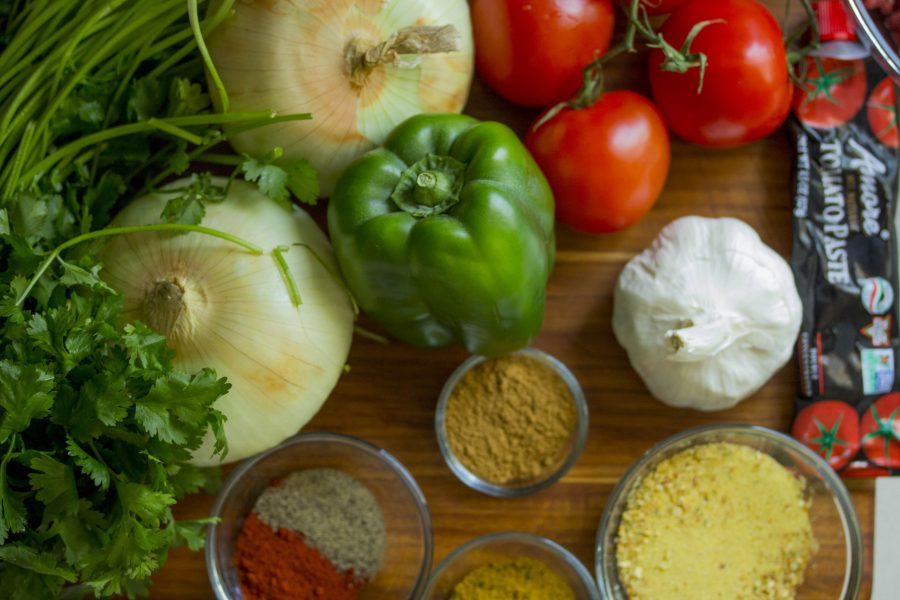Paprika
Smoked paprika brings a pop flavor to any dish. “It’s an especially good ingredient for bringing a smoky depth to vegan food, almost like bacon,” shares Linda Shiue, MD, an internal medicine physician and the Director of Culinary Medicine with Kaiser Permanente San Francisco. “This is made from capsicums/peppers and contains vitamin A, beta-carotene and other carotenoids. As antioxidants, carotenoids prevent cellular damage that can lead to chronic health problems, such as cardiovascular disease and arthritis.” Learn about more these foods packs with antioxidants.
Turmeric
Turmeric is a potent anti-inflammatory, similar to pharmaceutical Cox-2 inhibitors like Celebrex, says Dr. Shiue. “This is the golden orange spice ingredient that forms the base of curry powders. It can help with inflammatory conditions like arthritis and inflammatory bowel disease,” she says. Find out if turmeric is really worth all the hype.
Bulgur
A whole-wheat grain with a nutty taste that has been parboiled and then dried, bulgur can be prepared very quickly just by soaking in boiled water. “It can be used any place you’d use rice, and it can also be served cold as a grain salad base,” Dr. Shiue says. “Bulgur also a great food for diabetics because bulgur is high in fiber with a very low glycemic index, with little impact on blood sugar, unlike white rice.” Here are more whole-grain foods that will keep you full longer.
Cashew Cream
Have you used cashew cream as an ingredient yet? Dr. Shiue calls this food “a genius invention” that involves soaking raw cashews in water, then blending it with water to act as a plant-based substitute for cream or milk. “It’s a game-changer, allowing people who are avoiding animal products, dairy, and saturated fats to still enjoy the creamy flavor and texture. Like all nuts, cashews are rich in protein, fiber, iron and heart-healthy monounsaturated fat,” she continues.
Cumin
Another favorite ingredient for Dr. Shiue is cumin, which is a good source of fiber and minerals. “It has many phytochemicals with antioxidant and possible anti-microbial activity,” she adds. It also happens to be one of the spices that’s really good for your eyes.
Chia Seeds
Looking for a superfood which can be added to many everyday items without much notice? Chia seeds may be your new go-to. “Chia seeds can be added to smoothies, sprinkled on oatmeal and yogurt, mixed into baked goods and salad dressings or even making your own chia pudding is a great way to add fiber, healthy fats and protein,” says Caroline J. Cederquist, MD, bariatric doctor and founding physician of bistroMD, a weight-loss meal delivery service. “Just one ounce of these tiny seeds houses 10g of fiber and 5g of protein! Fiber adds bulk to our digestive movements while also reducing the net carbohydrates of your food, aiding in blood sugar stabilization.”
Edamame or Soybeans
Served as a side dish in their pods, mix these beans into grain salads, stir-fries or even added as a topping to salads. Soybeans are a complete, lean source of plant-based protein, suggests Dr. Cederquist. “A half cup provides about 9g of protein and 4g of fiber, providing a simple way to add extra power nutrients to your favorite meals.”
Avocado
Dr. Cederquist says healthy fats in your diet can improve heart health, help you feel fuller, and may curb cravings by keeping blood sugar stabilized. “Add avocado to an omelet in the morning or spread over whole grain bread with olive oil and tomatoes for a snack,” she suggests. “Avocados can be added to a smoothie for extra creaminess or even puréed with your milk of choice, lemon juice and a touch of sweetener, then frozen for a warm-weather alternative to traditional ice cream!” Here are some more reasons to add avocados to your meals.
Flaxseed
Robin Evans, MD, a board-certified dermatologist in private practice in Stamford, CT, keeps her skin glowing and body well by adding flaxseed to her morning breakfast, often to a bowl of fruit, such as organic berries, papaya, and pomegranate. “Flaxseed is rich in omega-3 fats and provides powerful anti-inflammatory and antioxidant benefits, making it one of the superfood seeds everyone should eat. It’s great for the gut and helps as a vegetarian and natural way to encourage regular bowel movements as well,” Dr. Evans says.
Garlic
Not only does garlic add a distinct and powerful flavor to a dish but also it brings a host of health benefits to the mix as well, says Kyrin Dunston MD, FACOG, an ob-gyn and functional medicine practitioner in Atlanta. “For a small caloric expense it contributes a significant amount of vitamins including B, C, selenium and zinc, all of which aid energy production and proper immune system function,” Dr. Dunston says. Along with the allium, the compound that gives garlic its distinctive odor, the proven health benefits are myriad and include lowering blood pressure and cholesterol, reduction in cold symptoms, improved bone health, reduction in dementia, and ultimately it may help you live longer.”
Ginger
Ginger is a go-to ingredient of Nesochi Okeke-Igbokwe, MD, MS, an internal medicine physician at NYU Langone Medical Center in New York. “I’m a huge fan of adding it to a lot of my meals, or drinking it in tea and other beverages,” she says. “The great thing about ginger is that not only does it have some wonderful antioxidant and anti-inflammatory properties, but more specifically the phenols in ginger really work to help alleviate certain gastrointestinal symptoms. Ginger has also been linked to easing menstrual pain and helping with chemotherapy induced nausea.” Learn more about the benefits of ginger.
Lentils
Filled with minerals, protein and soluble fiber, lentils are high in folate, manganese, iron, phosphorous, thiamin, potassium, and vitamin B6, and they’re a source of riboflavin, niacin, pantothenic acid, selenium, copper, magnesium and zinc, says Mimi Guarneri, MD, FACC, ABOIM, President, Academy of Integrative Health & Medicine and Medical Director, Guarneri Integrative Health in California. “Lentils are high in protein—important for vegetarians. I suggest including quinoa with your lentils to make a ‘complete’ protein equal to that of fish or meat.” Also she suggests to release the phytic acid that can inhibit the absorption of minerals, soak them and drain before cooking.
Berries
Organic berries are at the top Dr. Guraneri’s list for antioxidant and anti-inflammatory phytonutrients. “They are high in vitamin C, a natural fighter of free radicals and infection. They are also high in manganese, fiber and copper, and with their wide diversity of antioxidant and anti-inflammatory phytonutrients, they help fight disease and improve wellness,” she says. In particular, raspberry ketones, a compound in the berries, aids fat metabolism, thus helping to prevent obesity, she says. Here are some winning recipes that feature berries.
Oat Bran
Elizabeth Klodas, MD, a preventative cardiologist in Minneapolis, Minnesota, recommends increasing your soluble fiber intake by adding oat bran to foods where it blends in easily—like pasta sauce or smoothies. “Oat bran is high in soluble fiber which helps lower cholesterol,” she says.
Keep in Red
Dr. Klodas also says a glass of wine, preferably red can keep your heart healthy. “Studies have shown that one glass of wine per day—five ounces, red preferred—reduces the risk of heart disease and dementia,” she says. This is what happens when you drink a glass of wine every night.
This article originally appeared in Readers Digest






